Beauty Holds the Fragrance Within
by Bob Brooke
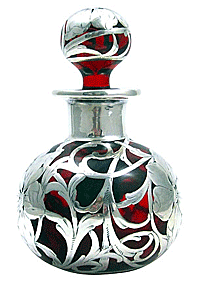 QUESTION: QUESTION:
I’ve always had a thing for fancy
perfume bottles. Those beautifully made, curvy and senuous ones from
the turn of the 20th century are my favorites. Recently, I purchased
several at antiques in my area. I don’t know anything about them
except that I really like them. Can you tell me something about
them?
Thanks,
Nancy
_________________________________________________________
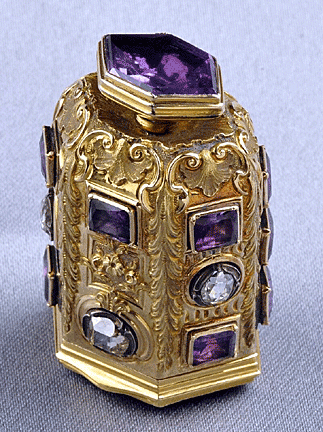 ANSWER:
For one thing, you bought these perfume bottles because you liked
them—what every good collector should do. And for another, you have
great taste and know beauty when you see it. ANSWER:
For one thing, you bought these perfume bottles because you liked
them—what every good collector should do. And for another, you have
great taste and know beauty when you see it.
With their elegant shapes, brilliant facets, and creative presentations,
vintage perfume bottles evoke the luxury and glamour of a bygone age.
The Egyptians created the oldest known perfume bottle around 1,000 BCE.
They used scents lavishly, especially in religious rites. When they
invented glass, they used it to make perfume vessels.
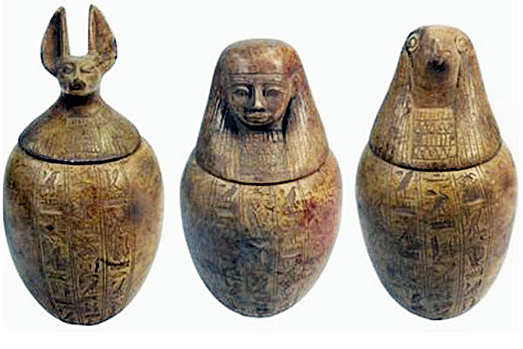
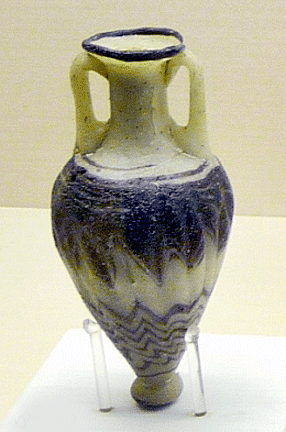 The
history of scent is ephemeral. The aromas of pressed lilies from the
Nile banks or the precious ambergris, once worth more than gold, would
be hard to imagine if people never smelled them. While the scent of
these delicate perfume ingredients vanishes over time, the beauty of the
vessels that contained them live on. The
history of scent is ephemeral. The aromas of pressed lilies from the
Nile banks or the precious ambergris, once worth more than gold, would
be hard to imagine if people never smelled them. While the scent of
these delicate perfume ingredients vanishes over time, the beauty of the
vessels that contained them live on.
Some of the earliest distilled and mixed perfumes came from ancient
Mesopotamia, India, and China. Ancient Egyptian perfume vessels date
back to at least the Middle Kingdom.
Delicate and beautifully crafted as symbolic vessels for the wealthy to
keep with their personal cosmetics. Perfume containers could be carved
from stones such as travertine marble or molded from faience. The
Egyptians used colorful glass for their cosmetic and perfume vessels.
They crafted these using a process called core-forming, in which
artisans dipped a soft form in molten glass at the end of a rod. Once
the glass hardened in the shape of the form, they scraped out the soft
interior form to create a hollow vessel.
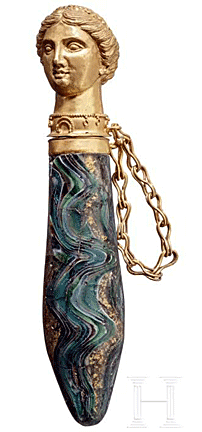 The
artisans of 18th Dynasty Egypt, lasting from 1549 to 1292 BCE, became
famous for their exquisite core-form works, often featuring striped
patterns in rich colors. This style of glassmaking spread to Classical
Greece. Known as alabastrons, these perfume bottles could be shaped like
vials or like amphorae. The
artisans of 18th Dynasty Egypt, lasting from 1549 to 1292 BCE, became
famous for their exquisite core-form works, often featuring striped
patterns in rich colors. This style of glassmaking spread to Classical
Greece. Known as alabastrons, these perfume bottles could be shaped like
vials or like amphorae.
With the invention of blown glass in the 1st century BCE, the Egyptians
eventually discontinued making core-formed vessel .From there, like
core-forming, glass blowing spread to the rapidly expanding Roman
Empire. By most accounts, upper-class Romans loved perfumes anointing
themselves from their hair to their feet.
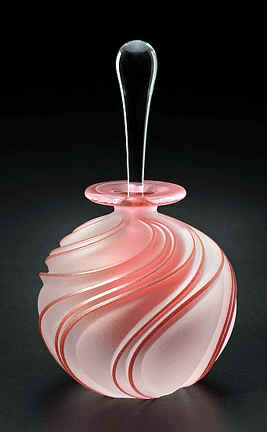 The
fashion for perfumes required large-scale production of perfume bottles.
The process of blowing glass created a new art form. More translucent
and faster to produce than core-formed or cast glass, glassblowing
encouraged a rapidly growing, ever-creative industry within the Empire.
Besides being beautiful, these blown glass perfume bottles were
non-porous and affordable. The
fashion for perfumes required large-scale production of perfume bottles.
The process of blowing glass created a new art form. More translucent
and faster to produce than core-formed or cast glass, glassblowing
encouraged a rapidly growing, ever-creative industry within the Empire.
Besides being beautiful, these blown glass perfume bottles were
non-porous and affordable.
The production of perfumes in Europe didn’t begin until the late Middle
Ages. Perfumers formed guilds, encouraged by royals and their courtiers,
to grow and protect their budding industry. The Italians perfected
alcohol-based perfume, called aqua mirabilis, or marvelous water, was a
powerful scented concoction. The need to bottle these luxurious perfumes
coincided with the growing Venetian glass industry.
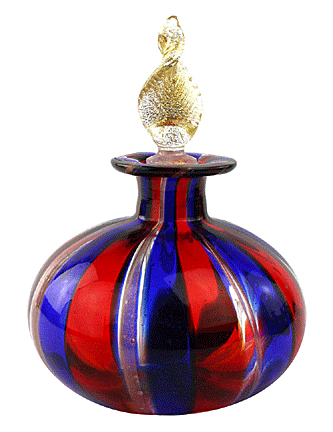 During
the late Middle Ages and Renaissance, perfumes came in exquisite vials.
Venice became known for producing delicate, thin glass vessels in a
style known as cristallo, or clear glass). This façon de Venise spread
around Europe throughout the Renaissance, as both perfumery and
glassmaking gained in popularity. During
the late Middle Ages and Renaissance, perfumes came in exquisite vials.
Venice became known for producing delicate, thin glass vessels in a
style known as cristallo, or clear glass). This façon de Venise spread
around Europe throughout the Renaissance, as both perfumery and
glassmaking gained in popularity.
By this time, perfume bottles could also be much smaller, so that people
could wear them on chains around their necks..The scents of the nobility
were often lavishly housed, sometimes in n carved agate and gold set
with rubies. These personal perfumes were handy in a world where bathing
and personal hygiene were primitive at best.
The fashions and artistic movements of the day heavily influenced
European perfume bottles of the 18th century. Crafted in glass,
porcelain, or even white glass masquerading as porcelain, scent bottles
were no longer the sole provision of the fabulously wealthy.
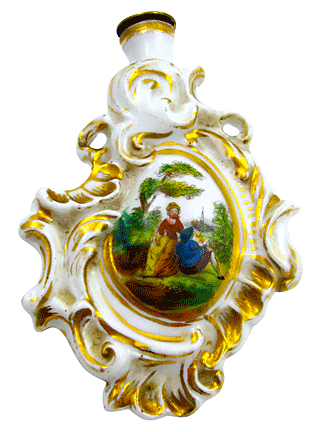 Borrowing
from Neoclassical styles, the scrolls and gilding of Rococo design, and
the Romantic pastoral scenes, perfume bottles followed the artistic
trends of both painting and the decorative arts. Production of perfume
vessels was also no longer exclusive to Italy. Artisans produced; fine
examples in Vienna, London, and other cities. Borrowing
from Neoclassical styles, the scrolls and gilding of Rococo design, and
the Romantic pastoral scenes, perfume bottles followed the artistic
trends of both painting and the decorative arts. Production of perfume
vessels was also no longer exclusive to Italy. Artisans produced; fine
examples in Vienna, London, and other cities.
While Neoclassical designs were popular in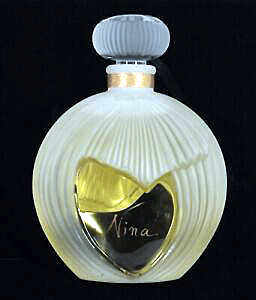 Europe, Americans preferred ornate decoration and cut or molded glass
perfume bottles. Jewelers such as Louis
Comfort Tiffany created luxury perfume vessels for the most affluent
consumers using agate decorated with gold and sapphires in an Art
Nouveau style.
Europe, Americans preferred ornate decoration and cut or molded glass
perfume bottles. Jewelers such as Louis
Comfort Tiffany created luxury perfume vessels for the most affluent
consumers using agate decorated with gold and sapphires in an Art
Nouveau style.
French jeweler René Lalique became known for his frosted glass perfume
bottles. Many 20th-century perfume bottles featured an atomizer, a late
19th-century invention that produces a fine spray from a liquid. While
perfume brands had name recognition in the 19th century, the bottles and
brands became identifiable as part of a larger fashion trend.
Decorative Perfume Bottles
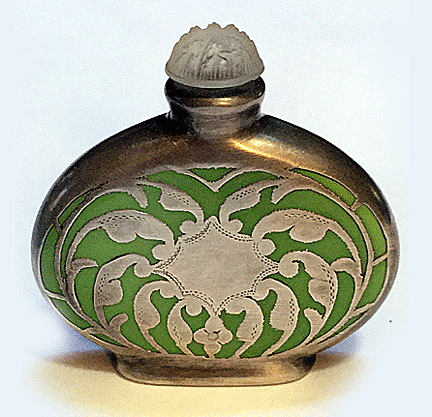 First
developed during the late 19th and early 20th century for both
advertising and merchandising purposes, perfumers developed ornate
perfume bottles to successfully market their fragrances. In order to do
so, theyy used imaginative elements and shapes to decorate the glass
bottles, with the intention of catching a prospective buyer's eye before
they even smelled the scent. From vanilla to sandalwood to rose-scented
perfumes, these glass and porcelain bottles were just as beautiful as
they were practical. First
developed during the late 19th and early 20th century for both
advertising and merchandising purposes, perfumers developed ornate
perfume bottles to successfully market their fragrances. In order to do
so, theyy used imaginative elements and shapes to decorate the glass
bottles, with the intention of catching a prospective buyer's eye before
they even smelled the scent. From vanilla to sandalwood to rose-scented
perfumes, these glass and porcelain bottles were just as beautiful as
they were practical.
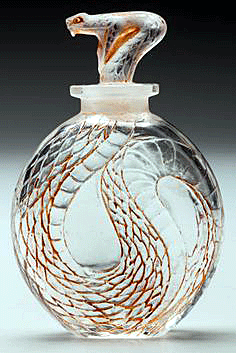 Of
all the creators of Art Nouveau perfume bottles, René Lalique, noted for
his impeccable artistry in glass design, was perhaps the most legendary.
His illustrious career began in 1881 as a designer of jewelry. He
eventually took over the workshop of jeweler Jules Destape in Paris. For
nearly a decade, Lalique concentrated exclusively on fine jewelry
design, but by 1890 he began his first experiments in designs using
glass. Of
all the creators of Art Nouveau perfume bottles, René Lalique, noted for
his impeccable artistry in glass design, was perhaps the most legendary.
His illustrious career began in 1881 as a designer of jewelry. He
eventually took over the workshop of jeweler Jules Destape in Paris. For
nearly a decade, Lalique concentrated exclusively on fine jewelry
design, but by 1890 he began his first experiments in designs using
glass.
Lalique’s glass items mimicked the natural forms, curvilinear designs,
and stylized women of his Art Nouveau jewelry creations. His perfume
bottles in particular propelled his reputation as a talented glass
designer into an international sensation. He first began to design them
at the request of his neighbor, legendary parfumier François Coty, who
greatly admired Lalique’s designs. In 1907, Coty commissioned Lalique to
first design labels, and then bottles and flasks. These were among the
first forays that Lalique made into glassmaking.
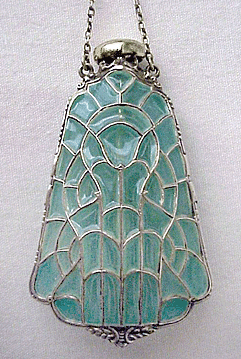 Perfume
bottle creation reached its peak during the Art Nouveau period.
Techniques such as pliqué-à-jour enameling particularly set these pieces
apart from bottles of any other style or period. Perfume
bottle creation reached its peak during the Art Nouveau period.
Techniques such as pliqué-à-jour enameling particularly set these pieces
apart from bottles of any other style or period.
The graceful, undulating curves that are typical of the Art Nouveau
style were particularly well suited to silver overlay. Most bottles
featuring this technique were crafted from clear glass, so those
examples that feature colored glass are today the most sought after by
collectors.
<
Back to Readers Ask Archives
Next Article >
|
